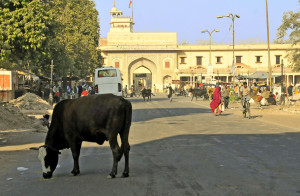Jaipur, a walled city of about three million people in northwest India, was founded in 1727 by Maharaja Sawai Jai Singh II. It has been known as the “pink city” since 1876, when buildings were painted pink to welcome Prince Edward (later King Edward VII). Jaipur’s most famous pink building, the Hawa Mahal (Palace of the Winds), has an intricate sandstone façade representing the crown of Krishna, a Hindu god often given the title of Gopala, the Protector of Cows. The cows protected by Krishna wander in and along Jaipur’s unusually broad streets, reflecting the Hindu conception of the divine. As Mahatma Gandhi once said, “The central fact of Hinduism is cow protection.”
Hindus, constituting about 80 percent of India’s population, believe that all sentient beings are animated by an essence called “Atman,” a name related to the English word “atmosphere.” They also believe the eternal Atman is indistinguishable from Brahman, the transcendent reality underlying all the traditional Hindu gods. As a result, most Hindus are vegetarians and see killing or even corralling animals in the same way they would see doing the same thing to a person or to a god. So, not only do cows roam freely in Indian cities, but so do monkeys and other animals.
Indians revere their cows more than the other animals in their streets because of what cows provide. During its life, a cow provides milk for families, dung for fire and fertilizer and muscles for farms, all without complaint. Upon its natural death, a cow provides skin for shoes and bones for buttons. So important is the cow to the Indian way of life that its name “gau mata” means “mother cow” and ancient Hindu texts refer to the cow as the mother of civilization.
In the crowded streets of Jaipur and other Indian cities, cows block traffic, cause accidents and create chaos in the markets. But efforts to curb their freedom even a little are met with protests. So the cows continue to roam, presenting a living illustration of the Hindu belief that the divine resides in all creatures, great and small.
